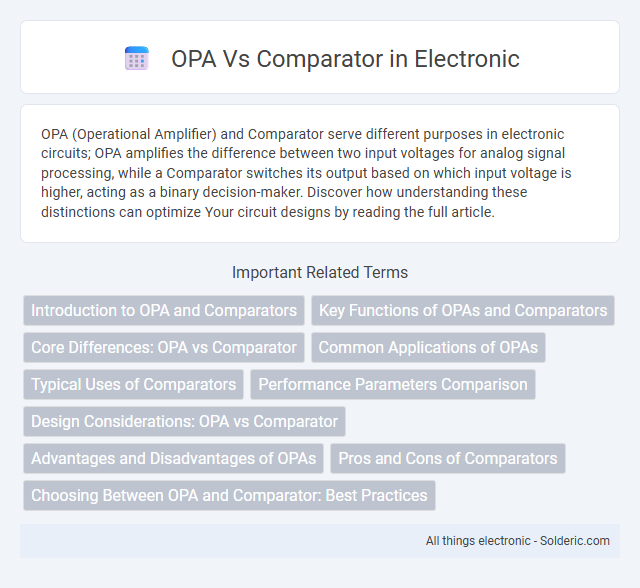OPA (Operational Amplifier) and Comparator serve different purposes in electronic circuits; OPA amplifies the difference between two input voltages for analog signal processing, while a Comparator switches its output based on which input voltage is higher, acting as a binary decision-maker. Discover how understanding these distinctions can optimize Your circuit designs by reading the full article.
Comparison Table
| Feature | Open Policy Agent (OPA) | Comparator |
|---|---|---|
| Purpose | Policy enforcement and decision-making engine | Tool or function for comparing data or values |
| Primary Use Case | Access control, authorization, compliance | Sorting, filtering, matching, validation |
| Implementation | Declarative policy language (Rego) | Function or method implemented in various languages |
| Output | Boolean or structured policy decisions | Comparison result (e.g., -1, 0, 1) |
| Scope | Comprehensive policy management | Specific data comparison tasks |
| Integration | Cloud-native, Kubernetes, CI/CD, microservices | Used within algorithms, data structures, sorting functions |
Introduction to OPA and Comparators
OPA (Operational Amplifier) is a versatile analog device used to amplify voltage signals with high gain and bandwidth, essential in signal conditioning and filtering applications. Comparators are specialized operational amplifiers designed to compare two input voltages and output a digital signal indicating which input is higher, commonly used in threshold detection and switching circuits. Your choice between an OPA and a comparator depends on whether you need analog signal amplification or binary level output for decision-making tasks.
Key Functions of OPAs and Comparators
Operational Amplifiers (OPAs) excel in signal amplification, filtering, and analog computation by providing high gain, differential input, and linear operation within a specified range. Comparators are designed to compare two voltages and output a digital signal indicating which input is higher, with fast switching times and hysteresis options for noise immunity. OPAs are ideal for continuous signal processing, while comparators are optimized for binary decision-making in threshold detection and waveform shaping.
Core Differences: OPA vs Comparator
Operational Amplifiers (OPAs) amplify voltage signals with high gain and are designed for linear applications, whereas comparators are designed to switch output states based on input voltage thresholds rather than amplify signals linearly. OPAs feature feedback mechanisms to control gain and maintain signal integrity, while comparators typically have open-loop configurations, providing fast switching with hysteresis options for noise immunity. The core difference lies in the OPA's role in analog signal conditioning versus the comparator's role in digital threshold detection and binary output generation.
Common Applications of OPAs
OPAs (Operational Amplifiers) are widely used in signal conditioning, filtering, and analog computation within audio equipment, sensor interfaces, and control systems. Their ability to perform mathematical operations such as integration, differentiation, and amplification makes them crucial for precision measurement and instrumentation. Your design benefits from OPAs when requiring high input impedance and stable gain across a broad frequency range, distinct from the discrete voltage comparison function of comparators.
Typical Uses of Comparators
Comparators are widely used in analog-to-digital converters (ADCs), zero-crossing detectors, and level shifters, where precise voltage comparison triggers digital output. Unlike operational amplifiers (OPAs), comparators operate with open-loop configurations designed for high-speed switching rather than linear amplification. Their typical applications include pulse-width modulation (PWM) circuits, window detectors, and over-voltage protection systems, benefiting from rapid response and hysteresis capabilities.
Performance Parameters Comparison
OPA (Operational Amplifiers) typically exhibit high input impedance, low output impedance, and bandwidth ranging from kHz to several MHz depending on the model, which influences their speed and signal fidelity. Comparators prioritize fast response times and high slew rates, often reaching tens of MHz to GHz, at the expense of linearity and precision found in OPAs. Key performance parameters such as offset voltage, propagation delay, and hysteresis significantly differentiate these devices; OPAs offer lower offset voltage for accuracy, whereas comparators deliver minimal propagation delay optimized for rapid switching applications.
Design Considerations: OPA vs Comparator
Operational amplifiers (OPAs) require careful attention to gain stability, input offset voltage, and bandwidth for linear amplification, whereas comparators prioritize fast response time, hysteresis design, and noise immunity to ensure accurate threshold detection. Power consumption and output stage design differ significantly; OPAs often emphasize low distortion and high linearity, while comparators focus on rapid switching and open-drain or push-pull outputs for interfacing. Layout considerations also vary, with OPAs demanding precision matching and low offset currents, contrasting with comparators that need minimized propagation delay and input overdrive protection.
Advantages and Disadvantages of OPAs
Operational Amplifiers (OPAs) offer high gain, broad bandwidth, and precise linear amplification, making them ideal for signal conditioning in analog circuits. They consume more power and require careful design to avoid issues like offset voltage and noise, which can affect accuracy. Unlike comparators that provide fast, binary output for threshold detection, OPAs excel in applications demanding proportional output and signal modulation.
Pros and Cons of Comparators
Comparators offer high precision in voltage comparison tasks with fast response times, making them ideal for applications like zero-crossing detectors and analog-to-digital conversion. However, comparators can introduce output noise and often require additional components such as hysteresis to avoid oscillations, which complicates circuit design. Unlike operational amplifiers (OPAs), comparators lack the gain stability for linear amplification, limiting their use to switching applications.
Choosing Between OPA and Comparator: Best Practices
Choosing between an Operational Amplifier (OPA) and a Comparator depends on the specific application requirements such as precision, speed, and output stage characteristics. OPAs are ideal for linear applications demanding low offset voltage and gain accuracy, while comparators are optimized for fast switching and definitive binary output. Carefully assess signal thresholds, response time, and noise immunity to determine the most effective component for your design.
OPA vs Comparator Infographic

 solderic.com
solderic.com